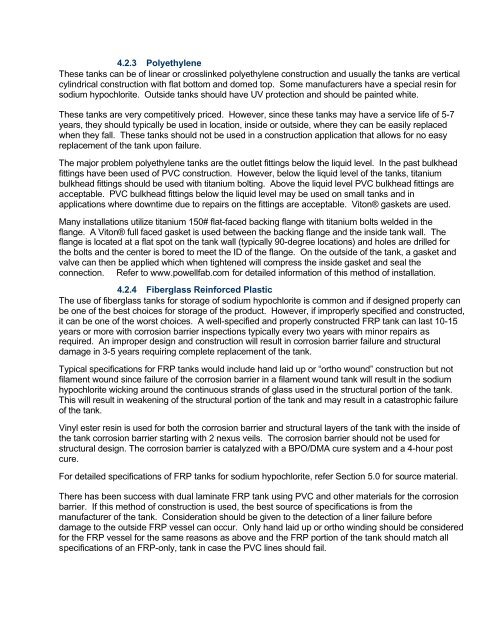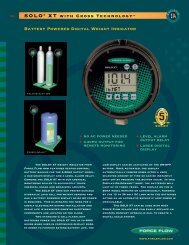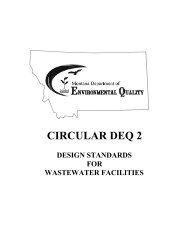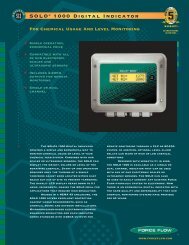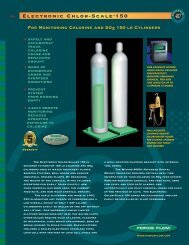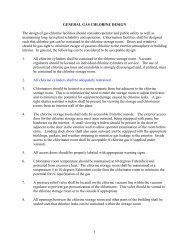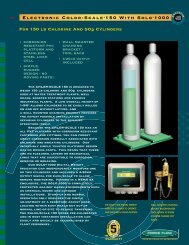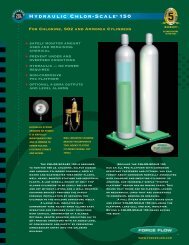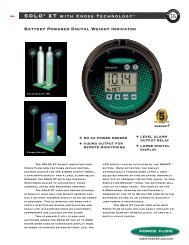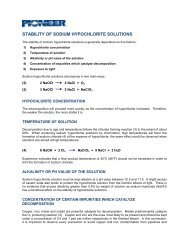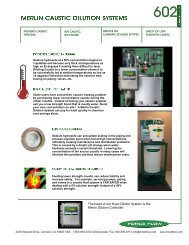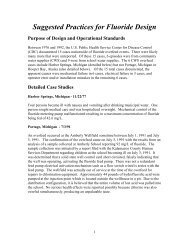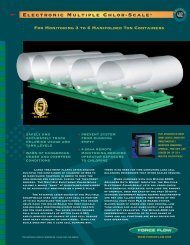Sodium Hypochlorite Handbook - Force Flow
Sodium Hypochlorite Handbook - Force Flow
Sodium Hypochlorite Handbook - Force Flow
Create successful ePaper yourself
Turn your PDF publications into a flip-book with our unique Google optimized e-Paper software.
4.2.3 PolyethyleneThese tanks can be of linear or crosslinked polyethylene construction and usually the tanks are verticalcylindrical construction with flat bottom and domed top. Some manufacturers have a special resin forsodium hypochlorite. Outside tanks should have UV protection and should be painted white.These tanks are very competitively priced. However, since these tanks may have a service life of 5-7years, they should typically be used in location, inside or outside, where they can be easily replacedwhen they fall. These tanks should not be used in a construction application that allows for no easyreplacement of the tank upon failure.The major problem polyethylene tanks are the outlet fittings below the liquid level. In the past bulkheadfittings have been used of PVC construction. However, below the liquid level of the tanks, titaniumbulkhead fittings should be used with titanium bolting. Above the liquid level PVC bulkhead fittings areacceptable. PVC bulkhead fittings below the liquid level may be used on small tanks and inapplications where downtime due to repairs on the fittings are acceptable. Viton® gaskets are used.Many installations utilize titanium 150# flat-faced backing flange with titanium bolts welded in theflange. A Viton® full faced gasket is used between the backing flange and the inside tank wall. Theflange is located at a flat spot on the tank wall (typically 90-degree locations) and holes are drilled forthe bolts and the center is bored to meet the ID of the flange. On the outside of the tank, a gasket andvalve can then be applied which when tightened will compress the inside gasket and seal theconnection. Refer to www.powellfab.com for detailed information of this method of installation.4.2.4 Fiberglass Reinforced PlasticThe use of fiberglass tanks for storage of sodium hypochlorite is common and if designed properly canbe one of the best choices for storage of the product. However, if improperly specified and constructed,it can be one of the worst choices. A well-specified and properly constructed FRP tank can last 10-15years or more with corrosion barrier inspections typically every two years with minor repairs asrequired. An improper design and construction will result in corrosion barrier failure and structuraldamage in 3-5 years requiring complete replacement of the tank.Typical specifications for FRP tanks would include hand laid up or “ortho wound” construction but notfilament wound since failure of the corrosion barrier in a filament wound tank will result in the sodiumhypochlorite wicking around the continuous strands of glass used in the structural portion of the tank.This will result in weakening of the structural portion of the tank and may result in a catastrophic failureof the tank.Vinyl ester resin is used for both the corrosion barrier and structural layers of the tank with the inside ofthe tank corrosion barrier starting with 2 nexus veils. The corrosion barrier should not be used forstructural design. The corrosion barrier is catalyzed with a BPO/DMA cure system and a 4-hour postcure.For detailed specifications of FRP tanks for sodium hypochlorite, refer Section 5.0 for source material.There has been success with dual laminate FRP tank using PVC and other materials for the corrosionbarrier. If this method of construction is used, the best source of specifications is from themanufacturer of the tank. Consideration should be given to the detection of a liner failure beforedamage to the outside FRP vessel can occur. Only hand laid up or ortho winding should be consideredfor the FRP vessel for the same reasons as above and the FRP portion of the tank should match allspecifications of an FRP-only, tank in case the PVC lines should fail.


